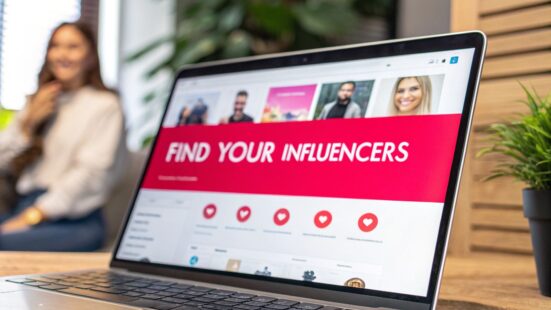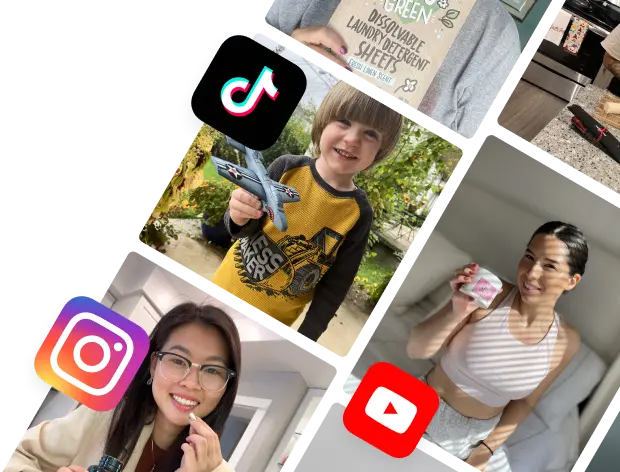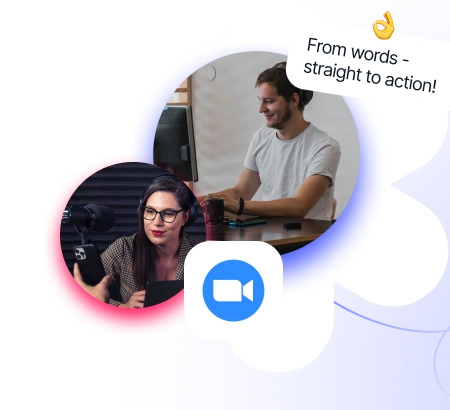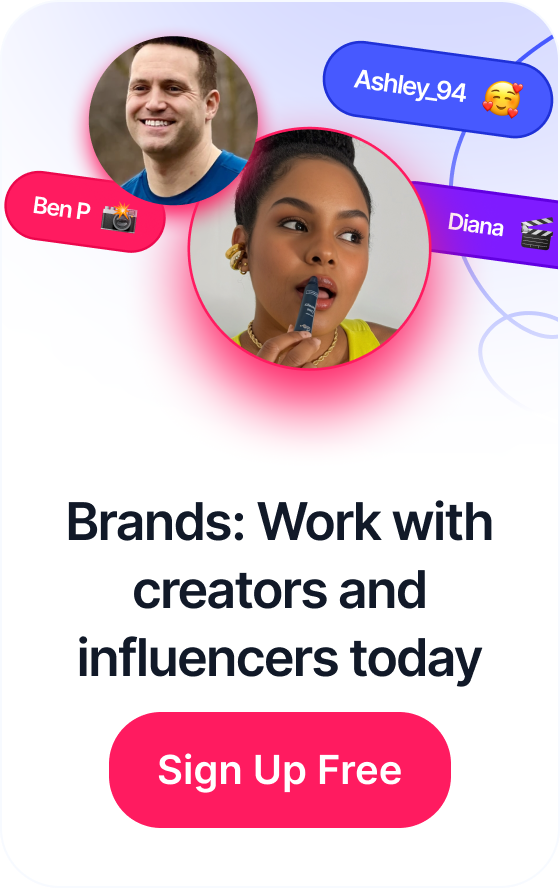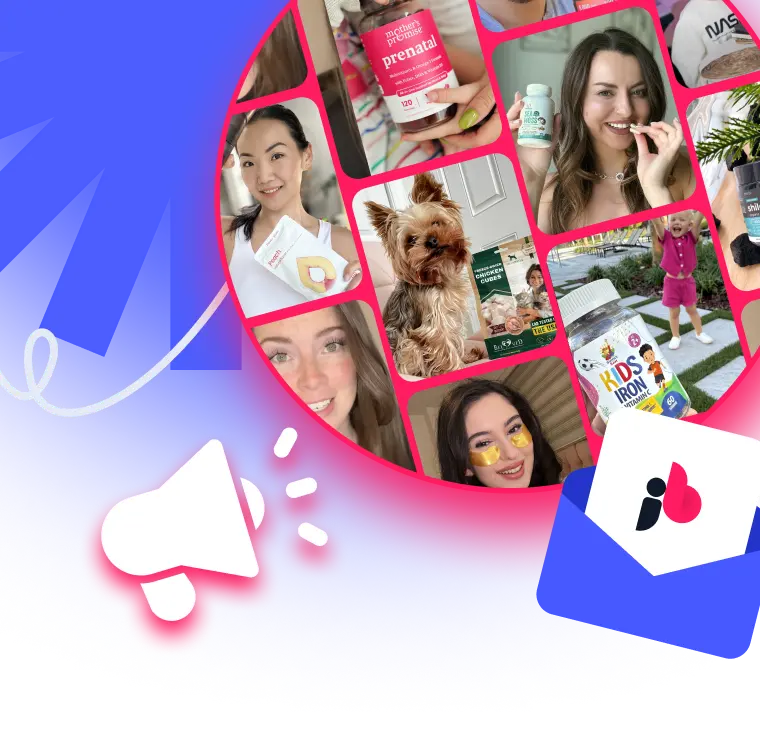 Find NFT Influencers – A-Z Guide, Criteria, Precautions, Pros, FAQs
Find NFT Influencers – A-Z Guide, Criteria, Precautions, Pros, FAQs
Table of Contents
The New Landscape of Influencer Partnerships
The influencer marketing world is constantly changing. Partnering with someone just because they have a large following isn’t enough anymore. Strategic selection and authentic audience connections are now prioritized by successful brands, moving beyond mere celebrity status.
This shift changes how we define “influence.” A mega-influencer with millions of followers might not be as effective as a micro-influencer with a smaller, highly engaged niche audience. Finding the right influencers requires a deeper understanding of your target audience and their online habits.
Understanding the Tiers of Influence
Different influencer tiers offer unique advantages for specific marketing goals. Nano-influencers, with smaller, highly engaged audiences, excel at building trust and driving conversions within niche communities. Micro-influencers offer a balance of reach and engagement, ideal for targeted campaigns.
Macro-influencers provide broader reach and increased brand awareness. Mega-influencers offer maximum visibility and widespread campaign exposure. Understanding these nuances helps tailor your influencer strategy to your specific goals.
The Rise of Data-Driven Influencer Marketing
This focus on strategic selection has fueled the adoption of data-driven platforms and AI-powered tools. As global influencer marketing expands, these tools are crucial for finding the right influencers. The Influencer Marketing Benchmark Report 2025 shows over 80% of marketers now believe influencer marketing is highly effective.
This has pushed the industry towards advanced technologies for influencer identification. 66.4% of marketers report improved campaign outcomes with AI integration, and 73% believe AI can automate parts of the influencer marketing process.
Furthermore, 55.8% of marketers specifically use AI tools to find the right influencers. This shift toward data and automation is clear. The influencer marketing platform industry is projected to reach nearly $33 billion in 2025. These technologies and analytics allow brands to analyze engagement rates, audience demographics, and content authenticity, ensuring partnerships are both authentic and effective. Brands can move beyond vanity metrics and focus on genuine connection.
Defining Your Influencer Success Blueprint
Before you begin your search for the perfect influencer, it’s essential to have a crystal-clear vision of what a successful partnership looks like. This means looking beyond superficial metrics like follower count and delving into what truly resonates with your target audience. Just like constructing a house, a solid blueprint is crucial before you even think about laying the first brick. This section will guide you through creating that essential blueprint for influencer marketing success.
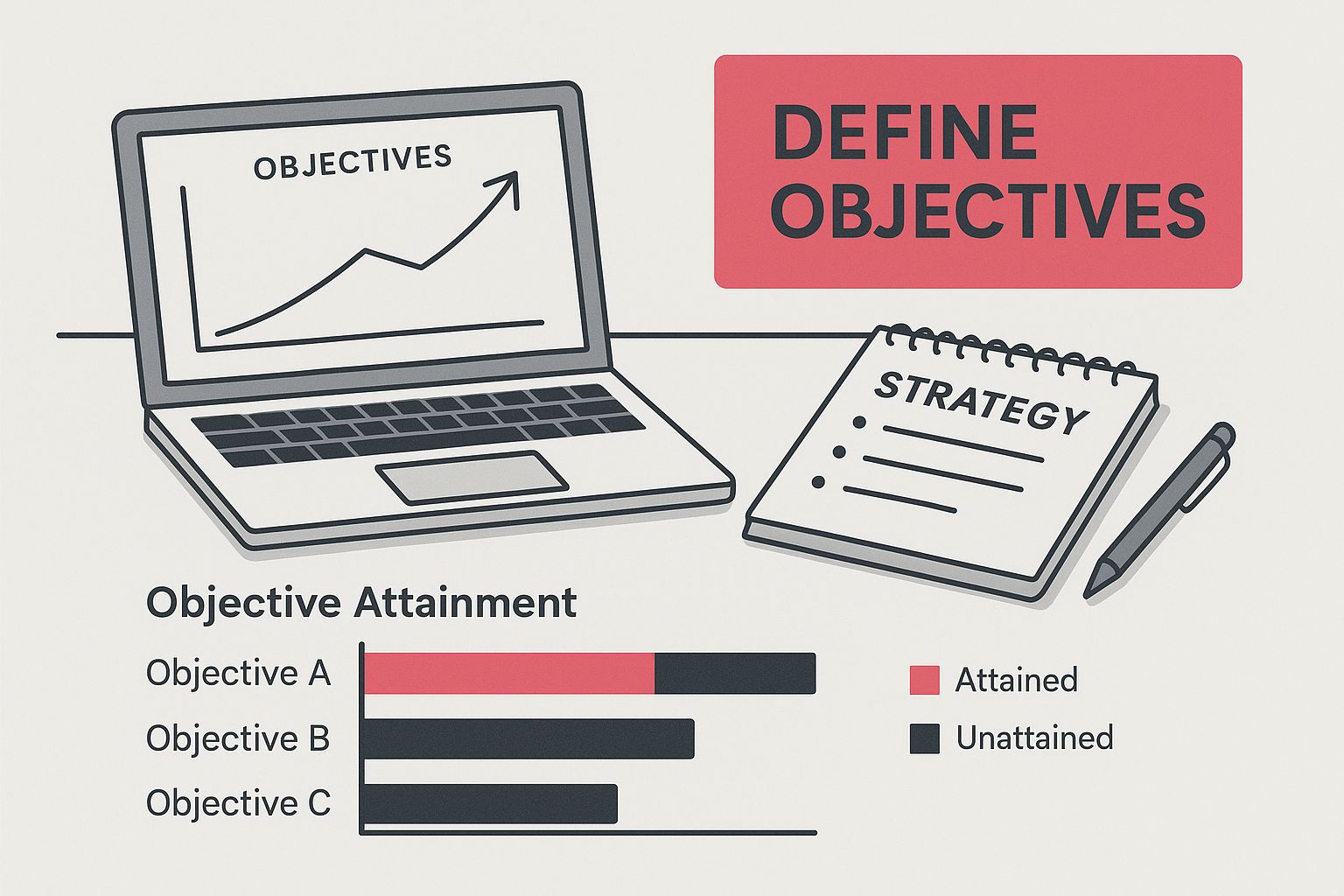
The infographic above illustrates the importance of defining your objectives before starting the influencer selection process. It underscores the fact that a well-defined strategy is paramount for successful influencer marketing. Clearly outlining your campaign goals ensures you choose influencers who align perfectly with your brand’s specific needs and target audience, setting the stage for a mutually beneficial partnership. For a deeper dive into microinfluencers, check out this helpful resource: How to find microinfluencers.
Building Your Influencer Persona
Defining your ideal influencer is akin to crafting a detailed character sketch. It streamlines your search and prevents wasted time on partnerships that won’t yield the desired results. This process begins with a deep understanding of your target audience. What are their passions? What type of content captures their attention? What values are most important to them?
Once you have a firm grasp of your audience, you can begin to envision your perfect influencer. This persona should encompass everything from their content style and audience demographics to their core values and brand affinities. For instance, if your brand champions sustainable living, collaborating with an influencer known for their eco-conscious lifestyle would be a natural fit. This alignment enhances authenticity and resonates powerfully with your target audience.
Setting Your Selection Criteria
With your ideal influencer persona in mind, you can now establish concrete selection criteria. This involves differentiating between essential criteria and flexible preferences. Essential criteria are non-negotiable, such as audience alignment and shared brand values. Flexible preferences might include specific content formats or expertise on a particular platform.
Imagine you’re shopping for a new car. You likely have non-negotiables like fuel efficiency and safety features, but you might be flexible on color or a sunroof. As influencer marketing continues to evolve, consider exploring specialized solutions like influencer marketing services. This structured approach guarantees that each partnership aligns with your overall marketing objectives and supports your brand’s unique goals.
To help you further define your selection criteria, let’s look at the key factors brands should consider:
Key Influencer Selection Criteria
A comprehensive overview of criteria brands should consider when developing their influencer selection framework
| Selection Factor | Why It Matters | How to Measure | Priority Level |
|---|---|---|---|
| Audience Alignment | Reaching the right people is crucial for campaign success. | Analyze audience demographics, interests, and engagement. | High |
| Brand Values | Shared values enhance authenticity and resonance. | Review influencer’s content and public statements. | High |
| Content Quality | High-quality content reflects well on your brand. | Assess creativity, production value, and storytelling. | High |
| Engagement Rate | Authentic engagement indicates a loyal audience. | Calculate likes, comments, and shares relative to follower count. | Medium |
| Platform Expertise | Different platforms require different strategies. | Evaluate influencer’s performance on specific platforms. | Medium |
| Cost | Budget considerations are always important. | Negotiate rates based on deliverables and ROI. | Medium |
This table highlights the critical factors to consider when selecting influencers, ensuring a strategic and effective approach. By prioritizing audience alignment and shared brand values, brands can maximize the impact of their influencer partnerships.
Evaluating Potential Partnerships
Finally, developing a systematic approach for evaluating potential influencer partnerships is paramount. This extends beyond simply checking follower numbers and involves a thorough analysis of engagement quality, audience authenticity, and content relevance.
For example, examining comment sections for genuine interactions and reviewing the influencer’s previous brand collaborations can provide invaluable insights. This evaluation process is similar to interviewing potential employees. You want to be certain they’re a good fit for your team and can contribute to your overall success. This meticulous approach helps maximize your return on investment and cultivate truly impactful influencer partnerships.
Technology Tools That Transform Influencer Discovery
Finding the right influencers can feel overwhelming. It’s often compared to searching for a needle in a haystack. Thankfully, technology offers a more efficient and targeted approach. Leading brands are using various tools to identify ideal influencer partners quickly and accurately. Let’s explore the key technologies changing influencer discovery and how they can streamline your search.
Influencer Marketing Platforms: Your Central Hub
Influencer marketing platforms are centralized databases offering comprehensive search capabilities and valuable data insights. Platforms like JoinBrands provide access to extensive creator networks, complete with detailed profiles and audience demographics. Instead of manually searching social media, you can use filters to narrow down potential partners.
These filters allow you to refine your search by niche, engagement rate, audience location, and more. For example, a skincare brand targeting Gen Z in the US can quickly filter for beauty influencers within that specific demographic. This targeted approach ensures your time is spent evaluating relevant creators. Many platforms also include features like campaign management, communication tools, and performance tracking within a single interface. This streamlines the entire influencer marketing process, from initial discovery to final reporting.
AI-Powered Discovery Tools: Predictive Power
AI-powered tools elevate influencer discovery beyond basic filtering. They use predictive analytics to analyze massive datasets, identifying rising stars before their rates increase and predicting campaign performance based on historical data. Some platforms even analyze influencer content to assess brand alignment and audience sentiment.
This added layer of intelligence empowers data-driven decisions, minimizing risk and maximizing your return on investment (ROI). It’s like having a dedicated influencer scout who can assess thousands of potential partners in mere seconds. By understanding which influencers resonate with your target audience and deliver results, you can make informed and strategic partnership choices.
Social Listening Tools: Uncovering Hidden Gems
Social listening tools provide a different perspective on influencer discovery. They monitor online conversations relevant to your brand and industry. These tools identify individuals actively engaging with your brand or competitors, even if they aren’t formally classified as “influencers.”
This approach helps uncover hidden gems: passionate advocates who may have smaller followings, but possess high engagement and authentic influence within their niche. Imagine a fitness apparel brand using social listening. They might discover fitness enthusiasts who regularly post about workouts and healthy lifestyles, generating high engagement within their community. Partnering with these individuals can offer a more authentic and cost-effective approach compared to celebrity endorsements.
Selecting the Right Technology for Your Brand
Choosing the right tools depends on your specific needs and resources. Smaller brands with limited budgets might begin with free social listening tools or influencer discovery platforms with basic search functionality. Larger brands with more complex campaigns might invest in comprehensive platforms with advanced AI features and analytics.
| Technology | Key Features | Best For |
|---|---|---|
| Influencer Marketing Platforms | Creator databases, campaign management, performance tracking | Brands of all sizes |
| AI-Powered Discovery Tools | Predictive analytics, brand alignment assessment, audience sentiment analysis | Brands focused on data-driven decisions and ROI |
| Social Listening Tools | Identifying hidden gems, monitoring brand conversations, understanding audience sentiment | Brands looking for authentic engagement and niche influencers |
This table provides a simple framework for evaluating your options. Combining multiple tools and techniques is often the most effective way to gain a holistic understanding of the influencer landscape. This multifaceted approach helps you pinpoint the right influencers for your brand.

Beyond Vanity Metrics: Evaluating True Influence
Follower counts and likes offer a glimpse into potential reach, but they don’t tell the whole story. While these vanity metrics can be deceiving, this section explores advanced techniques to evaluate an influencer’s true impact. We’ll dive into how to determine if their engagement is genuine and if their audience truly aligns with your brand. Finding the right influencers requires looking beyond the surface.
Identifying Red Flags: Unmasking Inauthenticity
One crucial step in influencer evaluation is identifying red flags. Sudden spikes in follower growth should raise eyebrows. Similarly, suspiciously high engagement rates compared to industry averages warrant a closer look. A disproportionate number of generic or irrelevant comments is another warning sign.
For example, an influencer with 10,000 followers consistently receiving 5,000 likes per post might be artificially inflating their metrics. These anomalies could indicate purchased followers, engagement pods, or other questionable tactics. This inflated influence may not translate into real results for your brand.
Analyzing Content and Audience Behavior
Beyond the numbers, the quality and consistency of an influencer’s content is essential. Examine the comment section for genuine interactions. Are the comments thoughtful and relevant, or do they appear generic and spammy?
Also, consider the influencer’s content evolution. Has their style or messaging changed drastically? Inconsistencies could indicate a shift in focus or authenticity. This analysis helps you understand their influence and how they might represent your brand.
Understanding Audience Demographics and Psychographics
Ensuring audience alignment with your target market is critical. This goes beyond basic demographics like age and location. Psychographics, which explore audience values, interests, and lifestyles, are equally vital.
If your brand targets eco-conscious millennials, partnering with an influencer promoting fast fashion wouldn’t be strategic. This careful matching ensures your message reaches the right people and resonates effectively. You might be interested in: How to master influencer relationship management.
Evaluating Partnership History and Audience Fatigue
Reviewing an influencer’s past brand collaborations offers valuable insights. Have they partnered with similar brands? Has their audience displayed “influencer fatigue,” becoming desensitized to sponsored content? Using technology can greatly improve your influencer discovery process. Similar strategies are used when searching for low hanging fruit keywords. Understanding their history helps assess potential conflicts and predict audience reception.
Requesting and Interpreting Audience Data
Don’t hesitate to request audience data from potential partners. This could include demographics, engagement metrics, and even audience surveys. However, approach these requests respectfully and transparently. Explain why this data is important for a successful partnership.
This collaborative approach fosters trust and a stronger working relationship. By going beyond vanity metrics and using these evaluation techniques, you’ll be prepared to find the right influencers and create impactful partnerships.
To help you navigate this process, we’ve created a checklist:
The following table provides a framework for assessing influencer authenticity and audience alignment.
Authenticity Assessment Checklist
A detailed checklist for evaluating influencer authenticity and audience alignment before partnership
| Assessment Area | Warning Signs | Positive Indicators | Verification Method |
|---|---|---|---|
| Follower Growth | Sudden, unexplained spikes | Steady, organic growth | Analyze follower growth charts over time |
| Engagement Rate | Unusually high compared to peers | Consistent engagement within industry benchmarks | Compare engagement rates using social listening tools |
| Comment Quality | Generic, irrelevant, or spammy comments | Thoughtful, relevant discussions | Manually review comments on recent posts |
| Content Consistency | Drastic changes in style or messaging | Consistent voice and themes | Analyze content history and evolution |
| Audience Demographics | Mismatch with target audience | Strong overlap with target demographics | Request audience demographics data from influencer |
| Audience Psychographics | Misalignment with brand values | Shared values and interests | Analyze audience sentiment and interests through social listening |
| Past Partnerships | Frequent collaborations with unrelated brands | Partnerships with complementary brands | Review influencer’s past collaborations and sponsored content |
| Audience Fatigue | Low engagement on sponsored posts | High engagement across all content types | Analyze engagement rates on sponsored vs. organic content |
By utilizing this checklist and the insights provided in this section, you can significantly improve your influencer selection process and ensure a higher return on investment.
Crafting Outreach That Earns Creator Attention
Top-tier influencers are constantly bombarded with partnership proposals. They often receive dozens, even hundreds, each week. So how can your brand cut through the noise and genuinely capture their attention? The key is to treat influencers as respected collaborators, not just advertising platforms. This means moving away from transactional outreach and embracing a relationship-focused approach. This section explores strategies that prioritize building genuine connections, leading to significantly improved response rates and higher-quality partnerships.
Personalization: The Key to Standing Out
Generic, mass-distributed messages are a surefire way to end up in the “deleted” folder. Influencers can easily spot a template. Instead, show genuine interest in their work. Reference specific content you appreciated, highlight shared values, or mention something unique about their brand.
For example, rather than saying “I love your content,” try “Your recent video on sustainable fashion really resonated with me, particularly your insights on thrifting.” This personalized touch shows you’ve invested time in understanding their work and aren’t just blasting out a form letter. Learn more in our article about How to Master Influencer Marketing Outreach.
Communicating Value: What’s in It for Them?
Clearly explain the mutual advantages of a partnership. Go beyond monetary compensation. Highlight opportunities for creative collaboration, audience expansion, and access to your brand’s resources. Influencers seek partnerships that benefit their own brand, not just yours.
Think of it as a two-way street. You need to demonstrate the value proposition for them, not just why they would be a good fit for you. This shows that you value their input and aren’t solely focused on what they can do for your brand.
Respecting Their Time: Keep It Concise and Actionable
Influencers have busy schedules. Respect their time by keeping your initial outreach brief and to the point. Clearly state your purpose, highlight key advantages, and include a clear call to action. Don’t bury the important information in paragraphs of unnecessary details.
For instance, instead of a long email detailing your entire brand history, lead with a concise introduction and a direct proposal for collaboration. This respectful approach makes a positive response more likely.
Common Outreach Mistakes to Avoid
Some outreach practices are immediate red flags for influencers. These include:
- Generic Mass Messaging: Steer clear of using templates without personalization.
- Unclear Expectations: Specifically define the scope of the project and expected deliverables.
- Lack of Brand Alignment: Make sure your brand values mesh with the influencer’s.
- Ignoring Their Previous Work: Show that you’ve familiarized yourself with their content.
Avoiding these common mistakes will significantly improve your odds of establishing a successful influencer partnership. You might be interested in: How to Master Influencer Marketing Outreach.
Structuring Initial Conversations for Success
The first conversation is essential for evaluating compatibility. Ask thoughtful questions to gauge their interest and confirm shared goals. Some important questions to consider include:
- What are your current partnership priorities?
- What kinds of brands do you enjoy collaborating with?
- What are your thoughts on [relevant industry trend]?
These open-ended questions can initiate meaningful discussions and reveal whether a partnership will truly benefit both sides. By prioritizing the development of genuine relationships and demonstrating respect, you can create outreach that not only attracts creator attention but also establishes a foundation for lasting, mutually beneficial partnerships.
The Advanced Vetting Playbook
Finding the right influencers can be a challenge. Thorough vetting is essential, separating successful partnerships from costly mistakes. This section unveils a multi-stage assessment process used by top brands to evaluate potential creators.
Deep Dive Into Content Archives: Aligning Values and Messaging
Start your vetting process with a comprehensive review of the influencer’s content archive. Look beyond recent posts and delve into their older content. This historical perspective reveals consistent messaging, authentic brand alignment, and potential past controversies.
For example, a brand promoting sustainability wouldn’t partner with an influencer who previously endorsed fast fashion. Examining past content ensures alignment and minimizes future conflicts, revealing the influencer’s true values and long-term brand compatibility.
Audience Sentiment Analysis: Gauging True Influence
Understanding audience sentiment is crucial. Analyze comments sections, use social listening tools, and even conduct audience surveys. Look for genuine engagement and positive sentiment towards the influencer and their content.
A high follower count doesn’t equate to true influence. An influencer with a smaller, highly engaged audience often delivers better results than one with a large, passive following. Prioritize quality engagement over quantity.
Uncovering Potential Controversies: Protecting Your Brand
Past controversies can derail a partnership. Conduct thorough background research, including social media audits and news searches. Look for patterns of problematic behavior, inconsistent messaging, or past brand conflicts.
This proactive approach safeguards your brand reputation and prevents negative associations. Just like due diligence before a business acquisition, influencer vetting protects your investment.
Trial Collaborations: Testing Compatibility
Before committing to a large campaign, consider a low-investment trial collaboration. This test run provides valuable insights into the influencer’s communication style, content creation process, and audience engagement.
A short-term social media takeover or a small product seeding campaign can reveal potential compatibility issues before they escalate. This trial minimizes risk and confirms mutual suitability.
Identifying Concerning Patterns: Refining Your Vetting Process
During the vetting process, watch for these concerning patterns:
- Communication Inconsistencies: Late responses, missed deadlines, or unclear communication.
- Content Quality Variations: Significant fluctuations in content quality.
- Misalignment With Campaign Objectives: Ensure the influencer understands and can contribute to your campaign goals.
These warning signs refine your vetting process and prevent potentially damaging partnerships.
Efficient Workflows for Vetting Success
Develop efficient workflows to streamline the vetting stage. Consider these strategies:
- Assessment Rubrics: Create clear evaluation criteria based on your brand’s needs.
- Team Responsibility Frameworks: Define roles and responsibilities for each vetting stage.
- Documentation Practices: Maintain detailed records of your findings to track progress and improve your selection process.
These structured approaches ensure a consistent, objective, and data-driven process.
Looking to streamline your influencer marketing? JoinBrands offers a platform to connect with creators, manage campaigns, and drive results.
